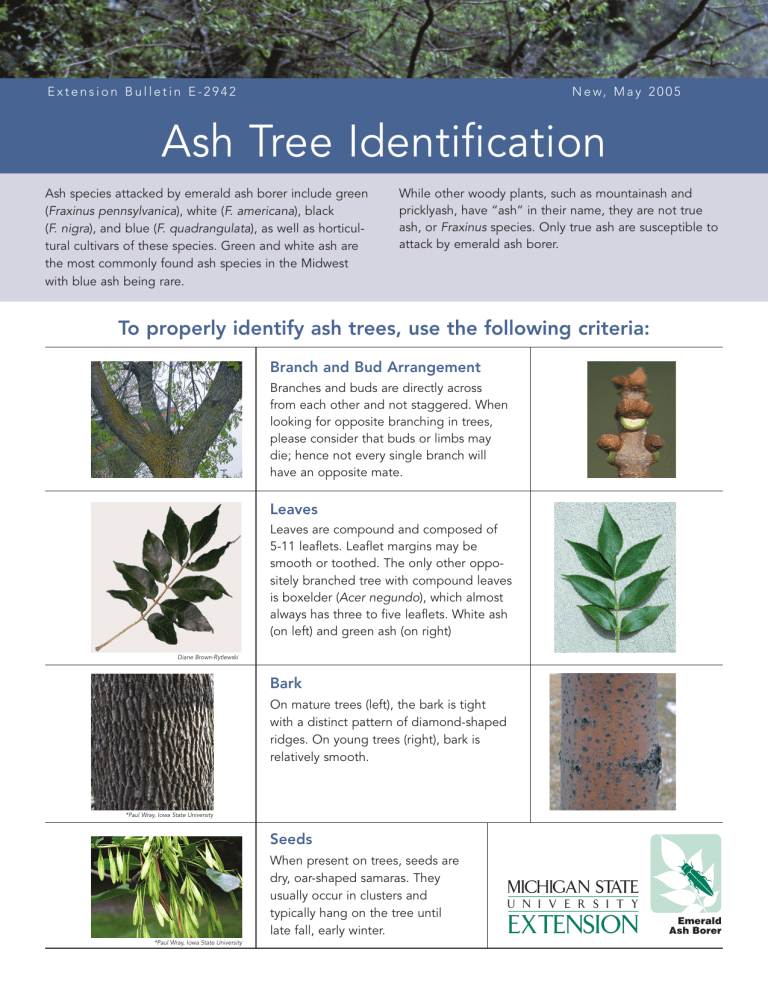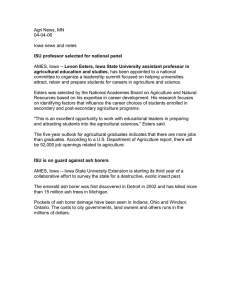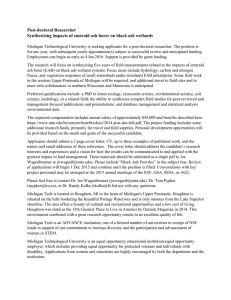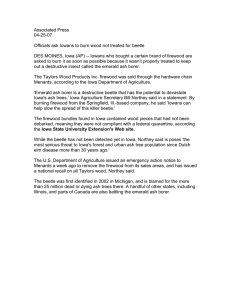Ash Tree Identification

E x t e n s i o n B u l l e t i n E - 2 9 4 2 N e w , M a y 2 0 0 5
Ash Tree Identification
Ash species attacked by emerald ash borer include green
( Fraxinus pennsylvanica ), white ( F. americana ), black
( F. nigra ), and blue ( F. quadrangulata ), as well as horticultural cultivars of these species. Green and white ash are the most commonly found ash species in the Midwest with blue ash being rare.
While other woody plants, such as mountainash and pricklyash, have “ash” in their name, they are not true ash, or Fraxinus species. Only true ash are susceptible to attack by emerald ash borer.
To properly identify ash trees, use the following criteria:
Branch and Bud Arrangement
Branches and buds are directly across from each other and not staggered. When looking for opposite branching in trees, please consider that buds or limbs may die; hence not every single branch will have an opposite mate.
Leaves
Leaves are compound and composed of
5-11 leaflets. Leaflet margins may be smooth or toothed. The only other oppositely branched tree with compound leaves is boxelder ( Acer negundo ), which almost always has three to five leaflets. White ash
(on left) and green ash (on right)
Diane Brown-Rytlewski
Bark
On mature trees (left), the bark is tight with a distinct pattern of diamond-shaped ridges. On young trees (right), bark is relatively smooth.
*Paul Wray, Iowa State University
*Paul Wray, Iowa State University
Seeds
When present on trees, seeds are dry, oar-shaped samaras. They usually occur in clusters and typically hang on the tree until late fall, early winter.
MICHIGAN STATE
U N I V E R S I T Y
EXTENSION
Emerald
Ash Borer
A s h Tr e e I d e n t i f i c a t i o n
Tree Species Resembling Ash
Boxelder (Acer negundo)
Exhibits opposite branching and compound leaves.
However, has 3 to 5 leaflets (instead of 5 to 11) and the samaras are always in pairs instead of single like the ash.
European Mountainash
(Sorbus aucuparia)
Leaves are compound with alternate (staggered) branching. Tree bears clusters of creamy white flowers in May.
Fruits are fleshy, red-orange berries.
*Paul Wray, Iowa State University *Bill Cook, Michigan State University
Shagbark Hickory (Carya ovata)
Leaves are compound with 5 to 7 leaflets, but the plant has an alternate branching habit. Fruit are hard-shelled nuts in a green husk.
Diane Brown-Rytlewski *Boris Hrasovec, University of Zagreb
Elm (Ulmus species)
Branching is alternate and the leaves are simple with an unequal leaf base.
*Paul Wray, Iowa State University *Paul Wray, Iowa State University *Paul Wray, Iowa State University *Paul Wray, Iowa State University
Black Walnut (Juglans nigra)
Leaves are compound with 9 to 15 leaflets, but the plant has an alternate branching habit. Fruit is a large dark brown nut inside a green husk.
*Paul Wray, Iowa State University
Authors: Kimberly Rebek and Mary Wilson
MICHIGAN STATE
U N I V E R S I T Y
EXTENSION
*Paul Wray, Iowa State University
*www.forestryimages.org
MSU is an affirmative-action, equal-opportunity institution. Michigan State University Extension programs and materials are open to all without regard to race, color, national origin, gender, religion, age, disability, political beliefs, sexual orientation, marital status, or family status. • Issued in furtherance of Extension work in agriculture and home economics, acts of May 8 and June 30, 1914, in cooperation with the U.S. Department of Agriculture. Thomas C. Coon, Extension director, Michigan
State University, E. Lansing, MI 48824. • This information is for educational purposes only. References to commercial products or trade names do not imply endorsement by MSU Extension or bias against those not mentioned. This bulletin becomes public property upon publication and may be printed verbatim with credit to
MSU. Reprinting cannot be used to endorse or advertise a commercial product or company. New - 5:05 - 6,250 - KMF/LB





